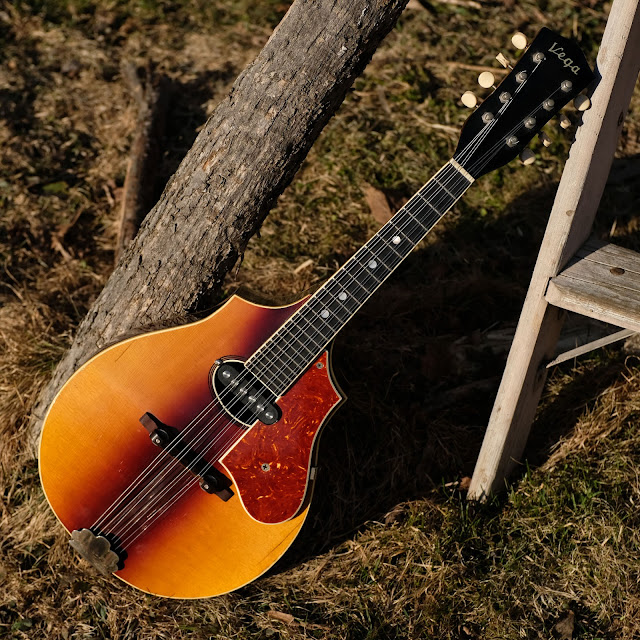1940s Vega L-100 Two-Point Electrified Mandolin
Update April 2018: I swapped the pickup for a better fit and so I've updated the description, pictures, and soundclip videos for this instrument.
Here's a new toy! I've been scheming about having a mandolin that pulls double-duty as an acoustic and an electric (in the "jazz guitar" sense). I've made several from funky old '30s Harmony and Regal products for customers in the past, and I'd played solidbody electric mandos that just didn't do it for me. To my hands a mandolin needs a bit of breath to sound right -- the sustain gets a little too long on a solidbody for my playing style. That didn't mean that I didn't drool over old Gibson and Fender electrics, though!
Here's a new toy! I've been scheming about having a mandolin that pulls double-duty as an acoustic and an electric (in the "jazz guitar" sense). I've made several from funky old '30s Harmony and Regal products for customers in the past, and I'd played solidbody electric mandos that just didn't do it for me. To my hands a mandolin needs a bit of breath to sound right -- the sustain gets a little too long on a solidbody for my playing style. That didn't mean that I didn't drool over old Gibson and Fender electrics, though!
I'd actually been eying the proper electric version of this mandolin on Reverb, but I wanted a "neck position" pickup location. When this acoustic version popped-up on eBay concurrently, I watched it like a hawk and scooped it up. It came to me in a pretty clean, all original state. The top is braced like older Vega canted-top/cylinder-back instruments and it has no bracing on the lower bout beyond the bridge. Because this top is simply domed a little rather than canted, this has yielded a mild "compression sink" in the top between the tailpiece and the bridge. It's perfectly stable and someone cleated the center-seam in the past, so it's not going anywhere. Further, the instrument is pitch-stable and not fussy in service.
As far as how the instrument feels and sounds -- yeah, it's definitely an upper-mid-grade or semi-professional instrument. It has solid spruce over solid mahogany, a mahogany neck, and ebony fretboard and bridge. The binding is cream and all over the place and the two-point style looks slick paired with the "reverse-sunburst" finish. Like most flatback instruments in the Vega and/or Larson tradition, the tone is sweet, clean, loud, and full but lacks the direct cut of f-hole carved-top instruments. This projects about like an average Gibson A.
My work on it was pretty light -- I gave it a fret level/dress, cleated and sealed hairline cracks on the top where needed, compensated and adjusted the bridge where necessary, installed the pickup in the soundhole and cut the pickguard for it, and wired it up with good, shielded, braided wire. The pickup is a new Seymour Duncan quarter-pounder-for-Strat unit at $60 or so. This has an Alnico magnet, high output, and flat poles, though I "compensated" the poles myself via shoving them up and down to match string-to-string volume (usually the A is far too loud and the E is too quiet). It's playing spot-on with 1/16" action at the 12th fret and strung with 36w, 26w, 14, 10 nickel strings. The acoustic sound is not effected much by the extra weight around the soundhole -- I played it both ways and the tiny change did not so much decrease volume as give it a slightly mellower sound as the soundhole is effectively smaller (smaller soundhole usually = darker tone while bigger = brighter).
This instrument has a 13 3/4" scale and 9 3/4" lower bout with a 2 1/4" depth along the sides. The nut is 1 1/8" and the string spacing is 7/8" at the nut and 1 5/8" at the bridge. The neck has a quick, mild, C-shaped cut to its rear and the board is flat.
The bone nut is original.
The dots are pearl in the ebony board.
I love that thick, 2-ply tortoise pickguard. I was fortunate in mounting this pickup as the bracing is so bulked-up near the soundhole that the acoustic tone isn't harmed with it slapped in there. This pickup type also doesn't have the normal triangular-shaped Strat-style baseplate, so it's not interrupting the soundhole as much as it might.
The bridge is, curiously, rosewood on top and stained maple on the bottom. I've seen this on period Vega archtop guitars so I know it's original.
It came with its original chip case and some goodies.

















Comments